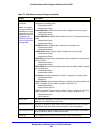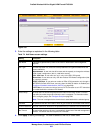
Manage Users, Authentication, and VPN Certificates
303
ProSafe Wireless-N 8-Port Gigabit VPN Firewall FVS318N
Edit Groups
For groups that were automatically created when you created a domain, you can modify only
the idle time-out settings but not the group name or associated domain.
For groups that you created on the Add Groups screen, you can modify the domain and the
idle
time-out settings but not the group name.
To edit a VPN group:
1. Select Us
ers > Groups. The Groups screen displays (see Figure 182 on page 301).
2. In the Action column of the List of Group
s table, click the Edit table button for the group that
you want to edit. The Edit Groups screen displays. This screen is identical to the Add
Groups screen.
3. Mo
dify the settings as explained in the previous table.
4. Click App
ly to save your changes. The modified group is displayed in the List of Groups
table.
Configure User Accounts
When you create a user account, you need to assign the user to a user group. When you
create a group, you need to assign the group to a domain that specifies the authentication
method. Therefore, you should first create any domains, then groups, and then user
accounts.
Note: IPSec VPN and L2TP users do not belong to a domain and are not
assigned to a group.
There are two default user accounts:
• A u
ser with the name admin and the password password. This is a user who has
read/write access, is associated with the domain geardomain, and is denied login from
the WAN interface by default. The user name is appended by an asterisk. You cannot
delete this user account.
• A u
ser with the name guest and the password password. This is a user who has
read-only access, is associated with the domain geardomain, and is denied login from the
WAN interface by default. The user name is appended by an asterisk. You cannot delete
this user account.
You can create five different types of user accounts by applying one of the predefined user
t
ypes:
• SSL VPN user.
A user who can log in only to the SSL VPN portal.
• Adm
inistrator. A user who has full access and the capacity to change the wireless VPN
firewall configuration (that is, read-write access).
• Guest
user. A user who can only view the wireless VPN firewall configuration (that is,
read-only access).


















